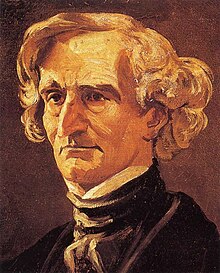Berlioz Festival
The Berlioz Festival is an international summer classical music festival that is held every year at the end of August in the French city of La Côte-Saint-André , the birthplace of the composer Hector Berlioz . The festival attracts the largest nationally and internationally recognized orchestras that perform important works of symphonic music from the romantic repertoire. The Berlioz Festival organizes numerous concerts, chamber music, contemporary installations, recitals, musical theater and more in the city and in the surrounding area.
The main venue is the palace courtyard of Ludwig XI., Which is so uniquely equipped that the audience is protected even in bad weather and in this way combines the acoustic qualities of a concert hall with the flair of an open-air event.
history
The origin: Hector Berlioz and the festival
Berlioz coined and at least helped to shape the concept of the festival . From the 1830s onwards, he organized a series of major musical events in one place and on a topic that he himself called festivalesque - a word he created. Among other things, he reports in his memoirs of these days, which often resulted in large banquets.
1979–1996 Serge Baudo: The beginnings
Even before the festival was founded, the composer's music was celebrated regionally. In 1930 the opera La damnation de Faust was performed in the medieval market hall with the support of the later French President Édouard Herriot , at the time mayor of Lyon, and among others also the dramaturge and poet Paul Claudel . From 1950 concerts in honor of the romantic composer were held regularly in La-Côte-Saint-André.
The festival was founded in Lyon in 1979 under the leadership of Serge Baudo , the conductor of the Orchester National de Lyon . The long-time head of the Paris Opera and internationally sought-after conductor of various orchestras, who was recognized worldwide for his interpretation of French music, brought great interest in the work of the composer Berlioz, even outside his country of birth. In 1987 he realized and conducted a sensational uncut version of the opera Les Troyens . He was the festival director until 1989.
The festival first took place in La-Côte-Saint-André in 1994; Senator Jean Boyer was now in charge of organizing the festival, and Alain Picard was the artistic director from 1994 to 1996.
1997–2008 Bernard Merlino: The Consolidation Phase
The 200th birthday of Hector Berlioz was celebrated in 2003 during the term of office of Bernard Merlino.
On the initiative of Merlinos the castle of Ludwig XI. the main venue for the symphonic concerts of the festival, which has undergone technical development. In 2003 the castle courtyard had 1500 seats and a stage 20 m wide and 16 m deep, equipped with a modular concert shell that can accommodate the largest orchestras and ensembles. In 2005, a unique weather protection for the audience and musicians was made to measure.
In 2004, the organization of the festival was entrusted to the Agence Iśeroise de Diffusion Artistique , AIDA, a subsidized agency for the promotion of culture in the Isère department , as well as the communes of La-Côte-Saint-André and the community of communes des Pays de Biève-Liers .
Over a period of twelve years, the festival had international guest conductors from Mstislav Rostropowitsch to Michel Plasson and Emmanuel Krivine .
Since 2009 Bruno Messina: New beginnings and renewal
The year 2009 represented a turning point in the history of the festival. Bruno Messina replaced Bernard Merlino as artistic director. Originally from Nice, trained as a classical and jazz musician, the director of the Maison de la Musique in Nanterre was a lighthouse figure in contemporary music. Messina was also active as a researcher in ethno-musicology and music history. From 2009 the festival was able to benefit from his passion for traditional music worldwide as well as from his talent for building bridges between classical and popular music. This marked the beginning of a new, creative and ambitious attempt for the festival to gain new sides from Berlioz's work.
In order to make classical music popular and accessible to everyone, Messina invented new forms of concerts , such as the Unter Hector's balcony series, whose concerts were held free of charge in the garden of Hector Berlioz's birthplace, as well as cinema screenings, readings, traveling concerts and street marching bands. In 2011 the marching band Fanfare de la touffe brought together 50 musicians between the ages of eight and 88 on the streets of La-Côte-Saint-André. The new forms of experience also included gastronomic events, banquets like in Berlioz's time.
Since taking over, Messina has been looking for new collaborations on an artistic level. Together with the orchestra Les Siècles and its conductor François-Xavier Roth , he created in 2010 the Jeune Orchester Européen Hector Berlioz, an orchestral academy for gifted students and young professionals aged 18 to 30 years, the half with musicians of the orchestra Les Siècles is busy . At the end of their training, this ensemble offers academy participants the opportunity to perform at the festival's final concert every year. In 2009 the collaboration with the Palazzetto Bru Zane (Center for French Romantic Music in Venice) began, which has set itself the task of rediscovering the musical French cultural heritage of the 19th century. Another way of approaching the composer is through the publications of his writings, including Mémoires (Memories) 2010, Les Grostesques (The Grotesques) 2011 and Les Soirées de l'Orchestre (The Evenings of the Orchestra) 2012.
Since Messina, the festival has a new theme every year:
- Famous Berlioz and his compositions, his inspirations, his contemporaries, his posterity, his writings (2009)
- Berlioz and the Romantics (2010)
- Berlioz, Liszt and the Devil (2011)
- Berlioz and Italy - a Roman Carnival (2012)
- Berlioz, the orchestra man (2013)
- Berlioz in America, at the time of the industrial revolution (2014)
- Berlioz in the footsteps of Napoleon (2015)
Web links
- Festival Berlioz (French, English, Italian)
